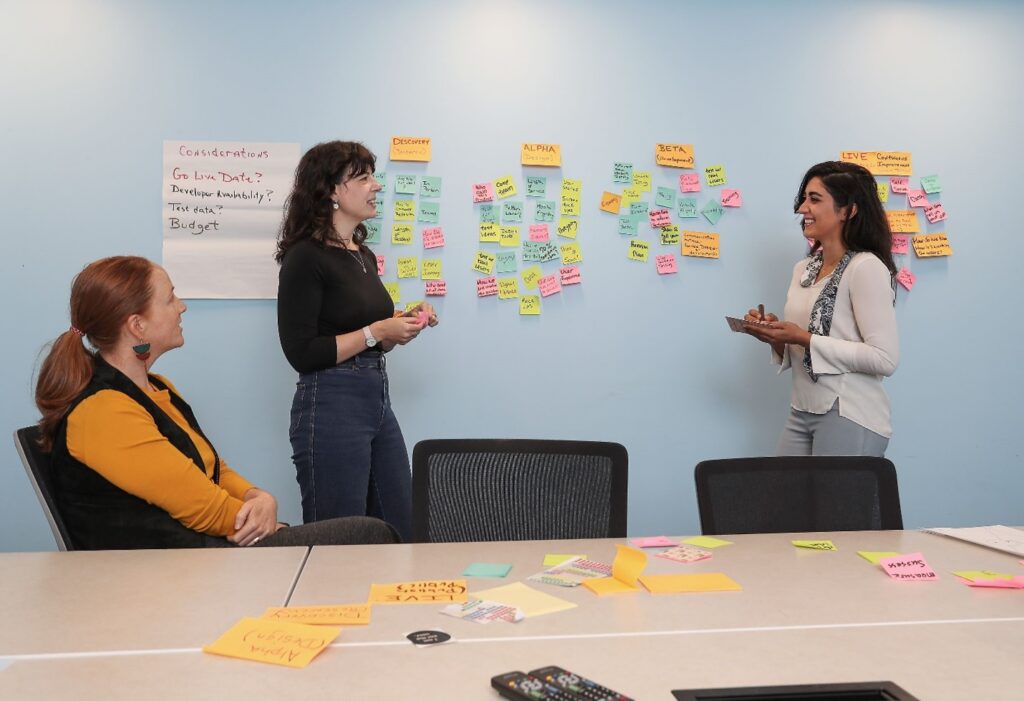By Gab Kelly, Service Designer and Acting Director – Human Centered Service Design, Department of Cyber Security and Digital Solutions (CSDS)
Service design is about understanding the entire end-to-end experience people have when interacting with government programs and services – both the citizens who use them and the staff who deliver them. The Human Centered Service Design team at CSDS is working to better serve our citizens by improving your experience with government’s programs and services.
What is service design?
Service design encompasses the people, processes, and tools that help power a service.
The design team partners with programs across government by facilitating service design activities to collaboratively create a service that puts user needs at the center. In most cases, the service design journey includes five phases:
- team alignment – getting to know who we’re working with and establishing our working norms
- research – understanding the user needs for the service
- design – creating and testing prototypes with small user groups
- development – building the service, whether digital or paper based
- continuous improvement – scaling a service and iterating based on user needs as things change

Our role in the service design journey is to collaborate with our design team partners to create a shared understanding, build empathy, and make the process easier for everyone.
As the process starts, our conversations with these teams will help us understand each other’s roles and how we’ll work together to manage expectations and leverage strengths. We need to understand:
- who is using the service
- what they’re trying to do
- how they’re trying to do it now
- what challenges or barriers they face when using the service
User research is the core of what we do
Connecting with those who use our programs and services is fundamental to our work – they are at the center of all we do. We also gather insights from government staff who deliver the services so we can understand how both sides interact with the service.
User-centered research can take on many forms ranging from quantitative (how many / how often) to qualitative (why / how) so we can capture insights on user needs and identify patterns in user experiences. Some of the methods we use include:
- interviews to uncover people’s attitudes, beliefs, behaviors, and experiences when interacting with a service
- reviewing existing processes and tools to identify opportunities to simplify processes or understand barriers in the technology
- journey mapping to identify challenges when interacting with the service, whether the exchange is through technology or with government staff
- observation – watching how users or staff interact with and react to a service to reveal pain points and workarounds that may not surface in conversation
No matter what combination of methods we use, our goal is to get multiple perspectives on the problem we’re trying to solve.
This process helps us understand what is working well and what needs to change through a series of “user stories” based on research insights. This helps us determine whether we need to look at a new technology or a process change, informs the project scope, and helps us decide on next steps.

Taking what we learned from the research, and working with subject matter experts, we can create a mock-up or prototype of the service. Modelling is an important part of iteration. Understanding that we’re designing for real people helps us be empathetic. Being able to test a prototype with real users helps us quickly identify what’s working and what’s not. If a design doesn’t work, we go back to the drawing board and try something else.
This aligns with CSDS’s goal of working in the open and “showing the thing” to get feedback from multiple perspectives which can accelerate our learning and help us develop creative solutions. It also helps us prioritize the “must haves” that we need now and the “nice to haves” that can happen later.
This is where usability testing comes in, to see if the design meets the needs and expectations of those who will use it. Getting feedback on our prototype from real users is the only way to know if it is meeting their needs. It also helps us identify gaps in the service and where the language or instructions may need to be made clearer.
Once we have iterated the service prototype based on the feedback during research and design, it’s time for development which can take anywhere from a few months up to a year.
Development can include an extensive range of activities where we might:
- turn designs into working code
- test in a development environment with real users
- document bugs, errors, and changes needed
- create training and change management plans to help internal staff adjust to the change
- create accessible forms and plain language instructions for the public that are simple, clear, and easy to understand
Once it’s launched
Our team doesn’t stop once the service is launched. As our lives and technology continue to change, we need to monitor the service with a “sustaining team” to make sure we iterate and continuously improve the user’s experience with our programs and services.
The Human Centered Service Design team is helping design accessible services for Nova Scotians across all departments. Our research focuses on those who may need support when accessing our services to help highlight where improvements can be made that will meet the needs of the majority of users. Our commitment to continuous improvement means we will strive to create sustainable collaborative partnerships across government to deliver the best services possible.
Stay tuned for more blogs with stories of our service design practice and how we use it make our services meet people’s needs!
